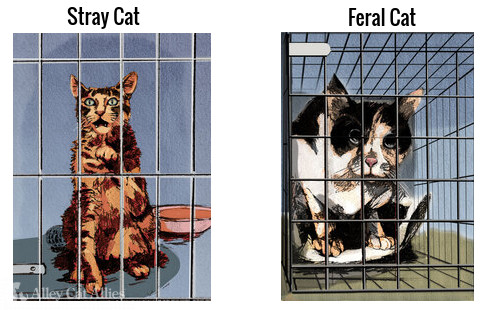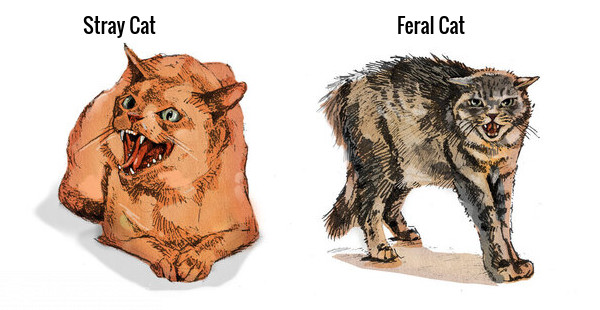Domestic cats (Felis catus) enrich our world in countless ways, whether as cherished indoor companions or as members of our outdoor communities. However, not all cats live the same lives, and understanding the nuances between different types of cats is crucial for effective and compassionate interaction. This article delves into the Cat Definition, exploring the distinctions between feral, stray, and community cats, and highlighting why recognizing these differences is vital for their well-being and our coexistence.
Defining Socialization in Cats
Before we differentiate between cat types, it’s essential to understand socialization in cats. Socialization refers to the process by which a cat becomes accustomed to and comfortable with human interaction. A socialized cat enjoys human companionship, tolerates being touched and handled, and is generally at ease in human environments.
This process primarily occurs during a critical period in a kitten’s early development. Kittens who are regularly handled, spoken to, and played with by humans within their first few weeks of life are more likely to become well-socialized. Conversely, kittens who lack positive human interaction during this period may develop a fear of humans and become unsocialized or feral. Early socialization is paramount for a cat to thrive as a pet and adapt to living in a home.
Stray Cats vs. Feral Cats: Key Differences in Cat Definition
While both stray and feral cats are considered community cats – an umbrella term for unowned outdoor cats – their backgrounds and levels of socialization differ significantly. Understanding this cat definition is critical for appropriate intervention and care.
Stray Cats: The Once-Socialized
A stray cat is defined as a domestic cat who was once socialized to humans and lived as a pet, but has become lost, abandoned, or strayed from their home. Stray cats retain some level of socialization to people, as they have experienced human contact in the past.
- Characteristics of Stray Cats:
- Former Pet: Stray cats have a history of living indoors and interacting with humans.
- Socialized (Initially): They were once comfortable with human presence and touch.
- Adaptable: Under the right circumstances, stray cats can often re-adjust to living with people and may be rehomed.
- May Seek Human Contact: Stray cats may approach people, houses, or cars, seeking food or shelter.
- Visible During the Day: They are often active during daylight hours.
- May Vocalize: Stray cats may meow or respond to human voices.
- Body Language: They may exhibit body language similar to pet cats, such as walking with their tail up.
 Stray Cat Approaching a Person
Stray Cat Approaching a Person
However, it’s important to note that stray cats can become less socialized over time if they lack positive human interaction. Prolonged periods without human contact can lead to increased fear and a shift towards feral behaviors.
Feral Cats: Unsocialized and Wild
In contrast, a feral cat is defined as a domestic cat who is not socialized to humans. Feral cats have either never had positive physical contact with people, or their contact has diminished to the point where they are no longer accustomed to it. They are essentially wild animals living in a domestic cat form.
- Characteristics of Feral Cats:
- Unsocialized: Feral cats are fearful of humans and avoid human contact.
- Born Outdoors: Many feral cats are born outdoors to other feral cats.
- Independent: They are self-sufficient and adapted to outdoor survival.
- Avoid Human Contact: Feral cats will actively avoid people and seek hiding places when humans are present.
- Nocturnal Activity: They are often more active at night, though they may be seen occasionally during the day.
- Silent: Feral cats are less likely to vocalize towards humans; they typically do not meow, beg, or purr for human attention.
- Body Language: They may exhibit fearful body language, such as crouching low to the ground or avoiding eye contact.
- Colonies: Feral cats often live in colonies, forming social bonds with other cats.
 Feral Cat Hiding in Bushes
Feral Cat Hiding in Bushes
While adult feral cats are generally not suitable for indoor living or adoption, kittens born to feral cats can be socialized if they are handled and exposed to humans at a young age, ideally before 4 months old.
Community Cats: A Broader Cat Definition
The term community cat provides a broader cat definition. It encompasses any unowned domestic cat living outdoors, including both feral and stray cats. This umbrella term recognizes the reality that these cats are part of our shared community environment.
Community cats, regardless of their socialization level, generally thrive outdoors and are not suited to living indoors as pets. They are adapted to outdoor life and contribute to the ecosystem, often controlling rodent populations.
Why Distinguishing Between Cat Types Matters
Understanding the cat definition and differentiating between stray and feral cats is not just about semantics; it has significant implications for how we interact with and care for these animals.
- Informed Intervention: Knowing whether a cat is stray or feral helps determine the most appropriate course of action. Stray cats may benefit from rescue and rehoming efforts, while feral cats are best supported through Trap-Neuter-Return (TNR) programs.
- Humane Care: Misidentifying a feral cat as a stray and attempting to force socialization can be stressful and detrimental to the cat’s well-being. Conversely, ignoring a stray cat who could be rehomed deprives them of a potential indoor life.
- Effective TNR Programs: TNR is a humane and effective method for managing community cat populations. It involves trapping cats, neutering and vaccinating them, and returning them to their outdoor homes. TNR benefits all community cats, regardless of their socialization level, by preventing reproduction and improving their overall health and quality of life.
- Shelter Outcomes: Feral cats are often euthanized in animal shelters because they are deemed unadoptable. Recognizing feral cats and implementing TNR programs prevents unnecessary euthanasia and allows these cats to live out their natural lives outdoors.
Identifying Stray and Feral Cats: Behavioral and Physical Clues
Distinguishing between stray and feral cats, especially when they are outdoors or stressed, can be challenging. However, observing their behavior and physical characteristics can provide valuable clues.
Outdoors:
| Feature | Stray Cat | Feral Cat |
|---|---|---|
| Socialization to Humans | May approach people, houses, porches, cars | Avoids people, seeks hiding places |
| Socialization to Cats | May live alone | May belong to a colony |
| Body Language | May walk with tail up, make eye contact | Crawls, crouches, avoids eye contact |
| Vocalization | May meow, respond to voices | Rarely meows, silent towards humans |
| Schedule | Primarily active during daytime | More nocturnal, occasional daytime activity |
| Physical Appearance | May be dirty, disheveled, no eartip | Clean coat, may have eartip (if neutered) |
When Trapped:
| Feature | Stray Cat | Feral Cat |
|---|---|---|
| Touch Barrier | May tolerate some touching | Untouchable, even by caregivers |
| Cage Behavior | May come to front of cage, rub against it | Stays at back, retreats, may become frantic |
| Relaxation Level | May relax over time | Remains tense and unsocial |
| Responsiveness | May investigate toys or food | Ignores toys, food, household sounds |
| Fear/Anxiety | May hiss or growl to show anxiety | Aggressive if cornered, lashes out |
It’s crucial to remember that these are general guidelines, and individual cats may exhibit a range of behaviors. A scared stray cat may initially behave like a feral cat. Observing the cat over time and in different situations can provide a more accurate assessment.
Conclusion: Respecting the Cat Definition and Community Cats
Understanding the cat definition – particularly the distinctions between feral, stray, and community cats – is fundamental for responsible and compassionate cat advocacy and care. By recognizing the unique needs and behaviors of each type of cat, we can make informed decisions that prioritize their well-being. Supporting TNR programs for community cats, offering rehoming opportunities for stray cats, and educating the public about coexisting with cats outdoors are all essential steps towards creating a more humane and cat-friendly world. Ultimately, respecting the diverse lives of all cats, whether they are our indoor companions or our outdoor neighbors, enriches our communities and fosters a deeper appreciation for these remarkable animals.

